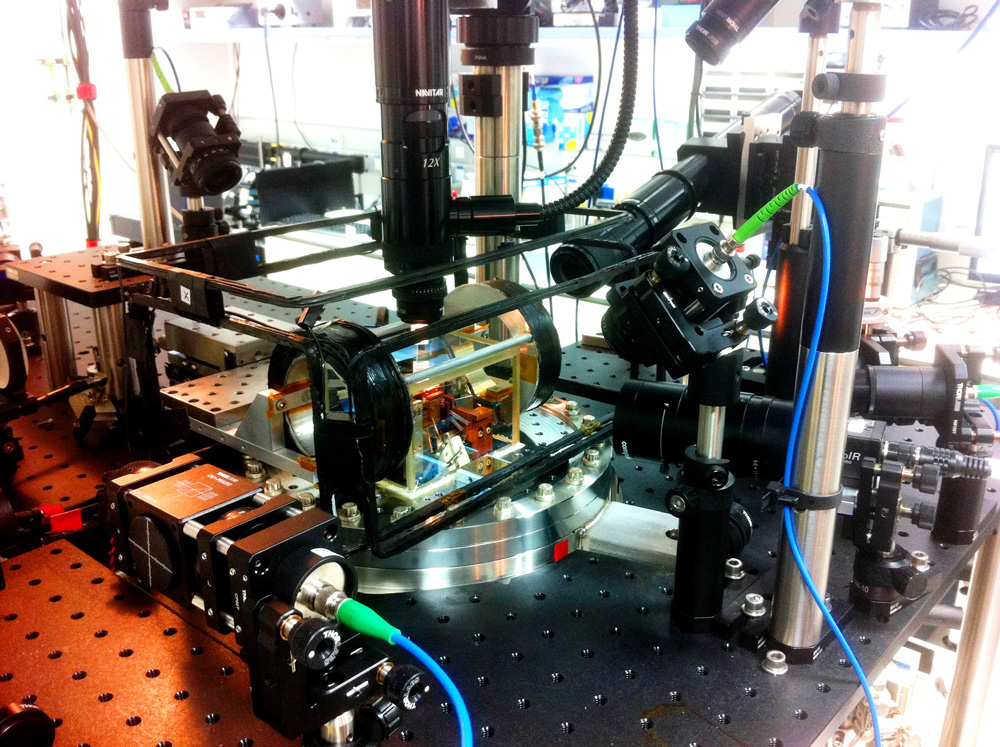The world’s first photonic router
July 17, 2014

Illustration of the photonic router the Weizmann Institute scientists created. At the center is the single atom (orange) that routes photons (yellow) in different directions. (Credit: Weizmann Institute)
Weizmann Institute scientists have demonstrated the first photonic router — a quantum device based on a single atom that enables routing of single photons, a step toward overcoming the difficulties in building quantum computers.
A photonic switch
At the core of the device is an atom that can switch between two states. The state is set just by sending a single particle of light — or photon — from the right or the left via an optical fiber.
The atom, in response, then reflects or transmits the next incoming photon, accordingly. For example, in one state, a photon coming from the right continues on its path to the left, whereas a photon coming from the left is reflected backwards, causing the atomic state to flip.
In this reversed state, the atom lets photons coming from the left continue in the same direction, while any photon coming from the right is reflected backwards, flipping the atomic state back again. This atom-based switch is solely operated by single photons — no additional external fields are required.
“In a sense, the device acts as the photonic equivalent of electronic transistors, which switch electric currents in response to other electric currents,” says Dr. Barak Dayan, head of the Weizmann Institute’s Quantum Optics group. The photons are both the units comprising the flow of information and the ones that control the device.

The photonic router (credit: Weizmann Institute)
This achievement was made possible by the combination of two state-of-the-art technologies.
One is laser cooling and trapping of atoms. The other is the fabrication of chip-based, ultra-high quality miniature optical resonators that couple directly to the optical fibers.
Dayan’s lab at the Weizmann Institute is one of a handful worldwide that has mastered both these technologies.
The main motivation behind the effort to develop quantum computers is the quantum phenomenon of superposition, in which particles can exist in many states at once, potentially being able to process huge amounts of data in parallel. Yet superposition can only last as long as nothing observes or measures the system otherwise it collapses to a single state.
Unlike atoms, photons are the most promising candidates for communication between quantum systems because they do not interact with each other at all, and interact very weakly with other particles.
Future possibilities
“In the current demonstration we used the single atom as a transistor — or a two-way switch — for photons, reflecting or transmitting a photon coming from one or the other direction in an optical fiber, according to a command given by a previous photon,” Dayan explained to KurzweilAI in a email.
“But this scheme can be directly implemented to construct other devices that are completely passive and work solely on photons. In the future, this scheme may become useful, for example, in designing quantum computers, which rely on quantum effects (and therefore must be based on simple systems such as single atoms and single photons), which are expected to be drastically stronger than regular computers.
“Being completely all-optical, this device demonstrates the feasibility of constructing large structures, in which there are many passive devices that communicate with and activate each other just by sending single photons — in a sense, creating the photonic version of very-large-scale electronic integrated circuits (VLSIs), which are the basis of today’s modern computers.”
The research is supported by the Benoziyo Endowment Fund for the Advancement of Science.
Abstract of Science paper
The prospect of quantum networks, in which quantum information is carried by single photons in photonic circuits, has long been the driving force behind the effort to achieve all-optical routing of single photons. Here, we realize a single-photon activated switch capable of routing a photon from any of its two inputs to any of its two outputs. Our device is based on a single atom coupled to a fiber-coupled, chip-based microresonator. A single reflected control photon toggles the switch from high reflection (R~65%) to high transmission (T~90%), with average of ~1.5 control photons per switching event (~3 including linear losses). No additional control fields are required. The control and target photons are both in-fiber and practically identical, making this scheme compatible with scalable architectures for quantum information processing.